Abstract
Dose-response and dose-suppression curves have been measured for the primary immune response in mice, in vivo and in vitro, by using size-fractionated linear polymers of acrylamide substituted with hapten. The results are in general agreement with a simple theory based on the premise that the specific primary immunological response is quantized at some fundamental and limiting step, requiring a minimum number of linked antigen receptors for response.
Full text
PDF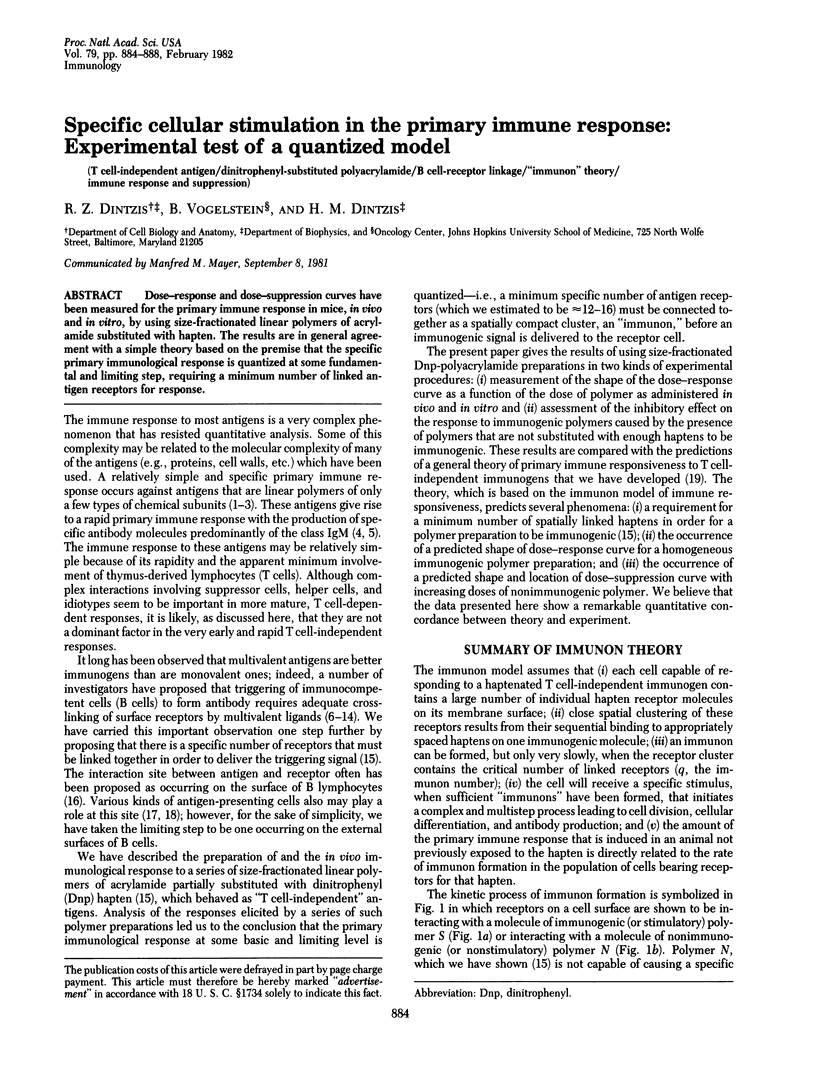
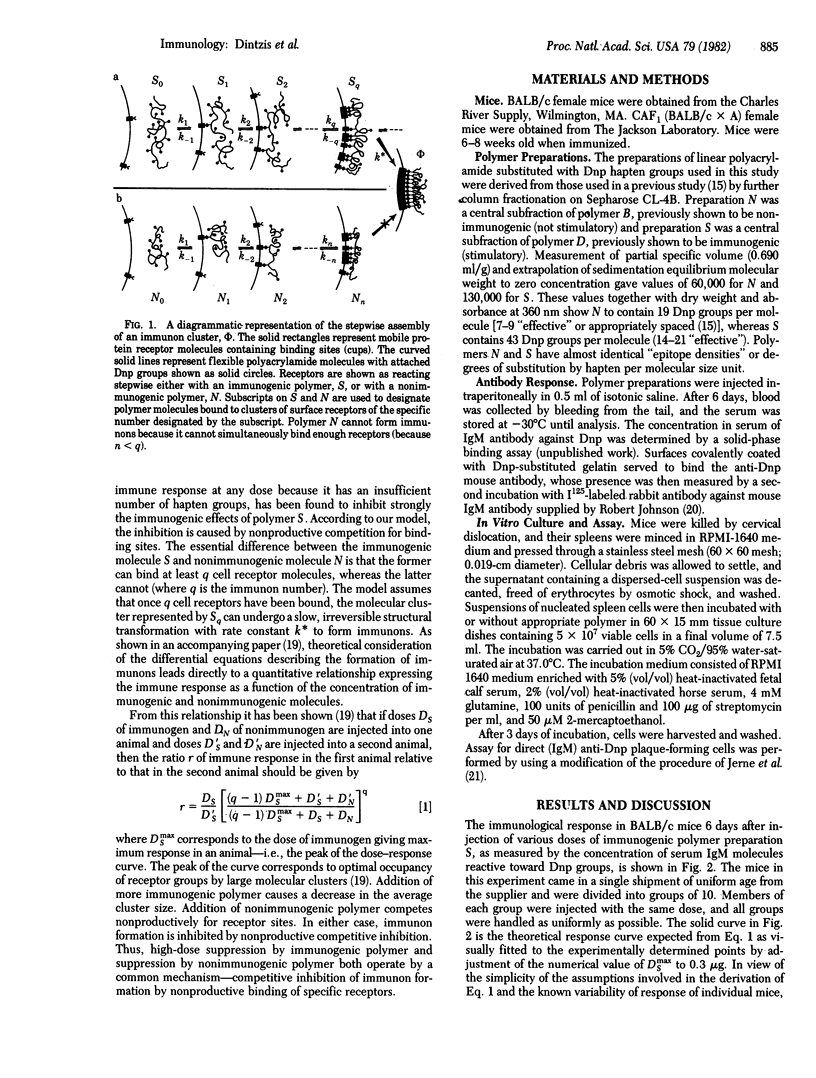
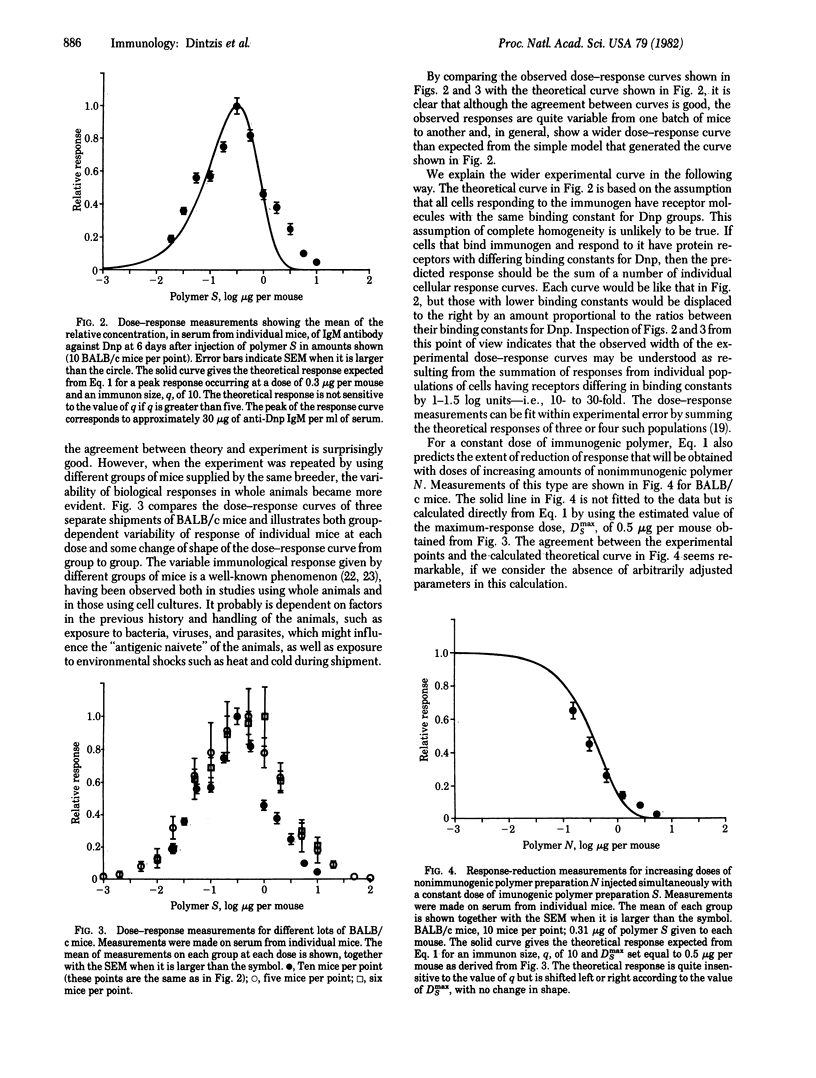
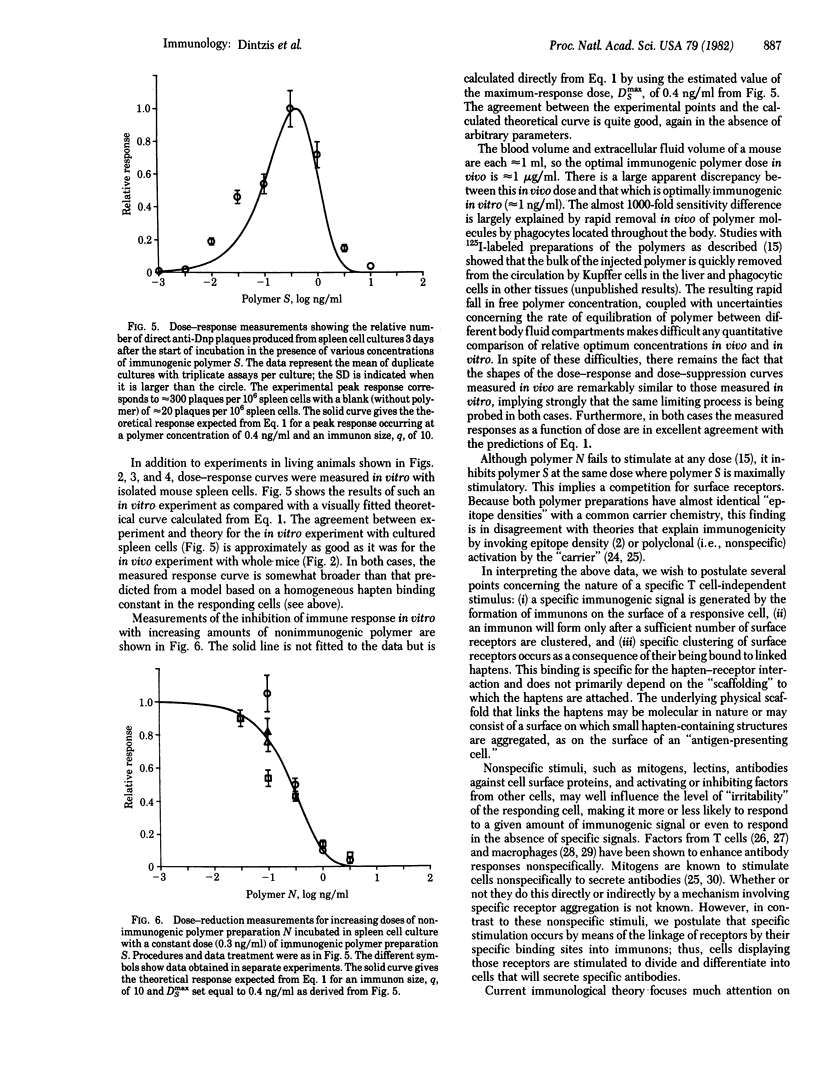
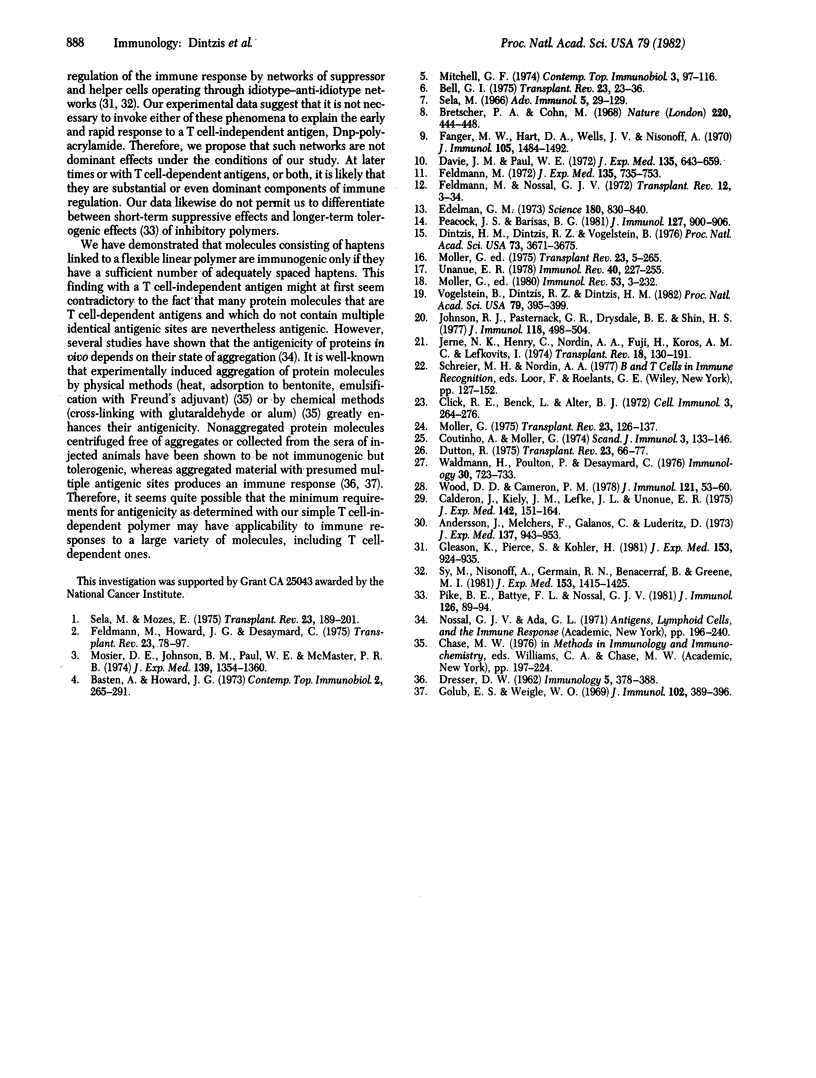
Selected References
These references are in PubMed. This may not be the complete list of references from this article.
- Andersson J., Melchers F., Galanos C., Lüderitz O. The mitogenic effect of lipopolysaccharide on bone marrow-derived mouse lymphocytes. Lipid A as the mitogenic part of the molecule. J Exp Med. 1973 Apr 1;137(4):943–953. doi: 10.1084/jem.137.4.943. [DOI] [PMC free article] [PubMed] [Google Scholar]
- Bell G. I. B lymphocyte activation and lattice formation. Transplant Rev. 1975;23:23–36. doi: 10.1111/j.1600-065x.1975.tb00146.x. [DOI] [PubMed] [Google Scholar]
- Bretscher P. A., Cohn M. Minimal model for the mechanism of antibody induction and paralysis by antigen. Nature. 1968 Nov 2;220(5166):444–448. doi: 10.1038/220444a0. [DOI] [PubMed] [Google Scholar]
- Calderon J., Kiely J. M., Lefko J. L., Unanue E. R. The modulation of lymphocyte functions by molecules secreted by macrophages. I. Description and partial biochemical analysis. J Exp Med. 1975 Jul 1;142(1):151–164. doi: 10.1084/jem.142.1.151. [DOI] [PMC free article] [PubMed] [Google Scholar]
- Click R. E., Benck L., Alter B. J. Immune responses in vitro. I. Culture conditions for antibody synthesis. Cell Immunol. 1972 Feb;3(2):264–276. doi: 10.1016/0008-8749(72)90165-7. [DOI] [PubMed] [Google Scholar]
- Coutinho A., Möller G. Editorial: Immune activation of B cells: evidence for 'one nonspecific triggering signal' not delivered by the Ig receptors. Scand J Immunol. 1974;3(2):133–146. [PubMed] [Google Scholar]
- DRESSER D. W. Specific inhibition of antibody production. II. Paralysis induced in adult mice by small quantities of protein antigen. Immunology. 1962 May;5:378–388. [PMC free article] [PubMed] [Google Scholar]
- Davie J. M., Paul W. E. Receptors on immunocompetent cells. IV. Direct measurement of avidity of cell receptors and cooperative binding of multivalent ligands. J Exp Med. 1972 Mar 1;135(3):643–659. doi: 10.1084/jem.135.3.643. [DOI] [PMC free article] [PubMed] [Google Scholar]
- Dintzis H. M., Dintzis R. Z., Vogelstein B. Molecular determinants of immunogenicity: the immunon model of immune response. Proc Natl Acad Sci U S A. 1976 Oct;73(10):3671–3675. doi: 10.1073/pnas.73.10.3671. [DOI] [PMC free article] [PubMed] [Google Scholar]
- Dutton R. W. Separate signals for the initiation of proliferation and differentiation in the b cell response to antigen. Transplant Rev. 1975;23:66–77. doi: 10.1111/j.1600-065x.1975.tb00149.x. [DOI] [PubMed] [Google Scholar]
- Edelman G. M. Antibody structure and molecular immunology. Science. 1973 May 25;180(4088):830–840. doi: 10.1126/science.180.4088.830. [DOI] [PubMed] [Google Scholar]
- Fanger M. W., Hart D. A., Wells J. V., Nisonoff A. Requirement for cross-linkage in the stimulation of transformation of rabbit peripheral lymphocytes by antiglobulin reagents. J Immunol. 1970 Dec;105(6):1484–1492. [PubMed] [Google Scholar]
- Feldmann M., Howard J. G., Desaymard C. Role of antigen structure in the discrimination between tolerance and immunity by b cells. Transplant Rev. 1975;23:78–97. doi: 10.1111/j.1600-065x.1975.tb00150.x. [DOI] [PubMed] [Google Scholar]
- Feldmann M. Induction of immunity and tolerance in vitro by hapten protein conjugates. I. The relationship between the degree of hapten conjugation and the immunogenicity of dinitrophenylated polymerized flagellin. J Exp Med. 1972 Apr 1;135(4):735–753. doi: 10.1084/jem.135.4.735. [DOI] [PMC free article] [PubMed] [Google Scholar]
- Feldmann M., Nossal G. J. Tolerance, enhancement and the regulation of interactions between T cells, B cells and macrophages. Transplant Rev. 1972;13:3–34. doi: 10.1111/j.1600-065x.1972.tb00058.x. [DOI] [PubMed] [Google Scholar]
- Gleason K., Pierce S., Köhler H. Generation of idiotype-specific T cell help through network perturbation. J Exp Med. 1981 Apr 1;153(4):924–935. doi: 10.1084/jem.153.4.924. [DOI] [PMC free article] [PubMed] [Google Scholar]
- Golub E. S., Weigle W. O. Studies on the induction of immunologic unresponsiveness. 3. Antigen form and mouse strain variation. J Immunol. 1969 Feb;102(2):389–396. [PubMed] [Google Scholar]
- Jerne N. K., Henry C., Nordin A. A., Fuji H., Koros A. M., Lefkovits I. Plaque forming cells: methodology and theory. Transplant Rev. 1974;18:130–191. doi: 10.1111/j.1600-065x.1974.tb01588.x. [DOI] [PubMed] [Google Scholar]
- Johnson R. J., Pasternack G. R., Drysdale B. E., Shin H. S. Antibody-mediated suppression of tumor growth. III. Molecular assay of murine IgG1 alloantibody required to cause tumor suppression in vivo. J Immunol. 1977 Feb;118(2):498–504. [PubMed] [Google Scholar]
- Mitchell G. F. T cell modification of B cell responses to antigen in mice. Contemp Top Immunobiol. 1974;3:97–116. doi: 10.1007/978-1-4684-3045-5_4. [DOI] [PubMed] [Google Scholar]
- Mosier D. E., Johnson B. M., Paul W. E., McMaster P. R. Cellular requirements for the primary in vitro antibody response to DNP-ficoll. J Exp Med. 1974 May 1;139(5):1354–1360. doi: 10.1084/jem.139.5.1354. [DOI] [PMC free article] [PubMed] [Google Scholar]
- Möller G. One non-specific signal triggers b lymphocytes. Transplant Rev. 1975;23:126–137. [PubMed] [Google Scholar]
- Peacock J. S., Barisas B. G. Photobleaching recovery studies of antigen-specific mouse lymphocyte stimulation by DNP-conjugated polymerized flagellin. J Immunol. 1981 Sep;127(3):900–906. [PubMed] [Google Scholar]
- Pike B. E., Battye F. L., Nossal G. J. Effect of hapten valency and carrier composition on the tolerogenic potential of hapten-protein conjugates. J Immunol. 1981 Jan;126(1):89–94. [PubMed] [Google Scholar]
- Sela M. Immunological studies with synthetic polypeptides. Adv Immunol. 1966;5:29–129. doi: 10.1016/s0065-2776(08)60272-2. [DOI] [PubMed] [Google Scholar]
- Sela M., Mozes E. The role of antigenic structure in B lymphocyte activation. Transplant Rev. 1975;23:189–201. doi: 10.1111/j.1600-065x.1975.tb00158.x. [DOI] [PubMed] [Google Scholar]
- Sy M. S., Nisonoff A., Germain R. N., Benacerraf B., Greene M. I. Antigen- and receptor-driven regulatory mechanisms. VIII. Suppression of idiotype-negative, p-azobenzenearsonate-specific T cells results from the interaction of an anti-idiotypic second-order T suppressor cell with a cross-reactive-idiotype-positive, p-azobenzenearsonate-primed T cell target. J Exp Med. 1981 Jun 1;153(6):1415–1425. doi: 10.1084/jem.153.6.1415. [DOI] [PMC free article] [PubMed] [Google Scholar]
- Unanue E. R. The regulation of lymphocyte functions by the macrophage. Immunol Rev. 1978;40:227–255. doi: 10.1111/j.1600-065x.1978.tb00408.x. [DOI] [PubMed] [Google Scholar]
- Unanue E. R. The regulation of lymphocyte functions by the macrophage. Immunol Rev. 1978;40:227–255. doi: 10.1111/j.1600-065x.1978.tb00408.x. [DOI] [PubMed] [Google Scholar]
- Vogelstein B., Dintzis R. Z., Dintzis H. M. Specific cellular stimulation in the primary immune response: a quantized model. Proc Natl Acad Sci U S A. 1982 Jan;79(2):395–399. doi: 10.1073/pnas.79.2.395. [DOI] [PMC free article] [PubMed] [Google Scholar]
- Waldmann H., Poulton P., Desaymard C. Antigen-non-specific T-cell factor in B-cell activation. Origin, biological properties and failure to show a relationship to H-2. Immunology. 1976 May;30(5):723–733. [PMC free article] [PubMed] [Google Scholar]
- Wood D. D., Cameron P. M. The relationship between bacterial endotoxin and human B cell-activating factor. J Immunol. 1978 Jul;121(1):53–60. [PubMed] [Google Scholar]


